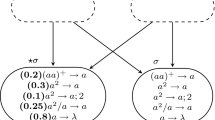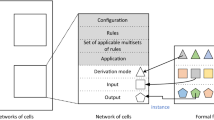Abstract
Spiking neural P systems (in short, SN P systems) are membrane computing models inspired by the pulse coding of information in biological neurons. SN P systems with standard rules have neurons that emit at most one spike (the pulse) each step, and have either an input or output neuron connected to the environment. A variant known as SN P modules generalize SN P systems by using extended rules (more than one spike can be emitted each step) and a set of input and output neurons. In this work we continue relating SN P modules and finite automata. In particular, we amend and improve previous constructions for the simulatons of deterministic finite automata and state transducers. Our improvements reduce the number of neurons from three down to one, so our results are optimal. We also simulate finite automata with output, and we use these simulations to generate automatic sequences.


Similar content being viewed by others
Notes
or ESN P systems, in short, are generalizations of SN P systems almost to the point of becoming tissue P systems. ESN P systems are thus generalizations also of (and not to be confused with) SN P systems with extended rules.
References
Allouche J-P, Shallit J (2003) Automatic sequences: theory, applications. Cambridge University Press, Cambridge
Cabarle FGC, Buño KC, Adorna HN (2012) Spiking neural P systems generating the Thue-Morse sequence. In: Asian conference on membrane computing (2012) pre-proceedings, pp 15–18 Oct. Wuhan, China
Cabarle FGC, Adorna HN, Pérez-Jiménez MJ, Song T (2015) Spiking neural P systems with structural plasticity. Neural Comput Appl 26(8):1905–1917
Chen H, Ionescu M, Ishdorj T-O, Păun A, Păun G, Pérez-Jiménez MJ (2008) Spiking neural P systems with extended rules: universality and languages. Natural Comput 7:147–166
Díaz-Pernil D, Peña-Cantillana F, Gutiérrez-Naranjo MA (2013) A parallel algorithm for skeletonizing images by using spiking neural P systems. Neurocomputing 115:81–91
Freund R, Oswald M (2008) Regular \(\omega\)-languages defined by finite extended spiking neural P systems. Fundam Inform 81(1–2):65–73
Goldin D, Smolka S, Wegner P (eds) (2006) Interactive computation: the new paradigm. Springer, Berlin
Ibarra O, Peréz-Jiménez MJ, Yokomori T (2010) On spiking neural P systems. Nat Comput 9:475–491
Ionescu M, Păun G, Yokomori T (2006) Spiking neural P systems. Fundam Inform 71(2,3):279–308
Leporati A, Zandron C, Ferretti C, Mauri G (2007) Solving numerical NP-complete problems with spiking neural P systems. In: Eleftherakis G, Kefalas P, Păun G, Rozenberg G, Salomaa A (eds) Membrane computing: 8th international workshop, WMC 2007 Thessaloniki, Greece, June 25-28, 2007 revised selected and invited papers, Springer, Berlin/Heidelberg, pp 336–352. doi:10.1007/978-3-540-77312-2_21
Maass W (2002) Computing with spikes. Found Inform Process TELEMATIK 8(1):32–36
Maass W, Bishop C (eds) (1999) Pulsed neural networks. MIT Press, Cambridge
Neary T (2010) A boundary between universality and non-universality in extended spiking neural P systems. In: Martin-Vide C, Fernau H, Dediu AH (eds) Language and automata theory and applications: 4th international conference, LATA 2010, Trier, Germany, May 24-28, 2010, Proceedings. Springer, Berlin/Heidelberg, pp 475–487. doi:10.1007/978-3-642-13089-2_40
Pan L, Păun G, Pérez-Jiménez MJ (2011) Spiking neural P systems with neuron division and budding. Sci China Inform Sci 54(8):1596–1607
Păun G (2002) Membrane computing: an introduction. Springer, Berlin
Păun A, Păun G (2007) Small universal spiking neural P systems. BioSystems 90(1):48–60
Păun G, Pérez-Jiménez MJ, Rozenberg G (2007) Computing morphisms by spiking neural P systems. J Found Comput Sci 8(6):1371–1382
Păun G, Pérez-Jiménez MJ (2009) Spiking neural P systems. Recent results, research topics. In: Condon A et al (eds) Algorithmic bioprocesses. Springer, Berlin
Păun G, Rozenberg G, Salomaa A (eds) (2010) The Oxford handbook of membrane computing. OUP, Oxford
Song T, Pan L (2015) Spiking neural P systems with rules on synapses working in maximum spikes consumption strategy. IEEE Trans NanoBiosci 14(1):38–44
Song T, Zou Q, Liu X, Zeng X (2015) Asynchronous spiking neural P systems with rules on synapses. NeuroComputing 152(2015):1439–1445
The P systems webpage http://ppage.psystems.eu/
Zeng X, Pan L, Pérez-Jiménez MJ (2013) Small universal simple spiking neural P systems with weights. Sci China Inform Sci 57(9):1–11
Zeng X, Zhang X, Song T, Pan L (2014) Spiking neural P systems with thresholds. Neural Comput 26(7):1340–1361
Zhang X, Pan L, Păun A (2015) On the universality of axon P systems. IEEE Trans Neural Netw Learn Syst 26(11):2816–2829
Acknowledgments
Cabarle is supported by a scholarship from the DOST-ERDT of the Philippines. Adorna is funded by a DOST-ERDT grant, the Semirara Mining Corp. professorial chair of the College of Engineering, UP Diliman, and the UP Diliman Gawad Tsanselor 2015 grant. M.J. Pérez-Jiménez acknowledges the support of the Project TIN2012-37434 of the “Ministerio de Economía y Competitividad” of Spain, co-financed by FEDER funds. Fruitful discussions with Miguel Ángel Martínez-del Amor are also acknowledged.
Author information
Authors and Affiliations
Corresponding author
Rights and permissions
About this article
Cite this article
Cabarle, F.G.C., Adorna, H.N. & Pérez-Jiménez, M.J. Notes on spiking neural P systems and finite automata. Nat Comput 15, 533–539 (2016). https://doi.org/10.1007/s11047-016-9563-4
Published:
Issue Date:
DOI: https://doi.org/10.1007/s11047-016-9563-4




